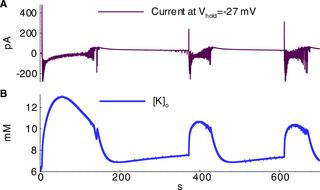Our official English website, www.x-mol.net, welcomes your feedback! (Note: you will need to create a separate account there.)
Mathematical model of Na-K-Cl homeostasis in ictal and interictal discharges.
PLOS ONE ( IF 3.7 ) Pub Date : 2019-03-15 , DOI: 10.1371/journal.pone.0213904 Anton V Chizhov 1, 2 , Dmitry V Amakhin 2 , Aleksey V Zaitsev 2
PLOS ONE ( IF 3.7 ) Pub Date : 2019-03-15 , DOI: 10.1371/journal.pone.0213904 Anton V Chizhov 1, 2 , Dmitry V Amakhin 2 , Aleksey V Zaitsev 2
Affiliation

|
Despite big experimental data on the phenomena and mechanisms of the generation of ictal and interictal discharges (IDs and IIDs), mathematical models that can describe the synaptic interactions of neurons and the ionic dynamics in biophysical detail are not well-established. Based on experimental recordings of combined hippocampal-entorhinal cortex slices from rats in a high-potassium and a low-magnesium solution containing 4-aminopyridine as well as previous observations of similar experimental models, this type of mathematical model has been developed. The model describes neuronal excitation through the application of the conductance-based refractory density approach for three neuronal populations: two populations of glutamatergic neurons with hyperpolarizing and depolarizing GABAergic synapses and one GABAergic population. The ionic dynamics account for the contributions of voltage-gated and synaptic channels, active and passive transporters, and diffusion. The relatively slow dynamics of potassium, chloride, and sodium ion concentrations determine the transitions from pure GABAergic IIDs to IDs and GABA-glutamatergic IIDs. The model reproduces different types of IIDs, including those initiated by interneurons; repetitive IDs; tonic and bursting modes of an ID composed of clustered IID-like events. The simulations revealed contributions from different ionic channels to the ion concentration dynamics before and during ID generation. The proposed model is a step forward to an optimal mathematical description of the mechanisms of epileptic discharges.
中文翻译:

Na-K-Cl稳态在发作和发作间放电中的数学模型。
尽管有大量实验数据表明了眼动和眼间放电(ID和IID)的产生及其机理,但是在生物物理细节中可以描述神经元的突触相互作用和离子动力学的数学模型仍未建立。基于在高钾和低镁溶液中包含4-氨基吡啶的大鼠海马-内膜联合皮质切片的实验记录以及类似实验模型的先前观察结果,已开发出这种类型的数学模型。该模型通过对三个神经元群体应用基于电导的不应性密度方法来描述神经元兴奋:两个具有超极化和去极化GABA能突触的谷氨酸能神经元群体和一个GABA能群体。离子动力学解释了电压门控和突触通道,主动和被动转运蛋白以及扩散的作用。钾,氯和钠离子浓度的相对较慢的变化决定了从纯GABA能IID到ID和GABA-谷氨酸能IID的转变。该模型可再现不同类型的IID,包括由中间神经元引发的IID。重复编号;由类似类IID的事件组成的ID的强音和爆发模式。模拟揭示了ID生成之前和生成期间,不同离子通道对离子浓度动态的贡献。所提出的模型是对癫痫放电机制进行最佳数学描述的一步。钾,氯和钠离子浓度的相对较慢的变化决定了从纯GABA能IID到ID和GABA谷氨酸能IID的转变。该模型可再现不同类型的IID,包括由中间神经元引发的IID。重复编号;由类似类IID的事件组成的ID的强音和爆发模式。模拟结果揭示了ID生成之前和生成期间,不同离子通道对离子浓度动态的贡献。所提出的模型是对癫痫放电机制进行最佳数学描述的一步。钾,氯和钠离子浓度的相对较慢的变化决定了从纯GABA能IID到ID和GABA-谷氨酸能IID的转变。该模型可再现不同类型的IID,包括由中间神经元引发的IID。重复编号;由类似类IID的事件组成的ID的强音和爆发模式。模拟揭示了ID生成之前和生成期间,不同离子通道对离子浓度动态的贡献。所提出的模型是对癫痫放电机制进行最佳数学描述的一步。重复ID;由类似类IID的事件组成的ID的强音和爆发模式。模拟揭示了ID生成之前和生成期间,不同离子通道对离子浓度动态的贡献。所提出的模型是对癫痫放电机制进行最佳数学描述的一步。重复编号;由类似类IID的事件组成的ID的强音和爆发模式。模拟揭示了ID生成之前和生成期间,不同离子通道对离子浓度动态的贡献。所提出的模型是对癫痫放电机制进行最佳数学描述的一步。
更新日期:2019-03-17
中文翻译:

Na-K-Cl稳态在发作和发作间放电中的数学模型。
尽管有大量实验数据表明了眼动和眼间放电(ID和IID)的产生及其机理,但是在生物物理细节中可以描述神经元的突触相互作用和离子动力学的数学模型仍未建立。基于在高钾和低镁溶液中包含4-氨基吡啶的大鼠海马-内膜联合皮质切片的实验记录以及类似实验模型的先前观察结果,已开发出这种类型的数学模型。该模型通过对三个神经元群体应用基于电导的不应性密度方法来描述神经元兴奋:两个具有超极化和去极化GABA能突触的谷氨酸能神经元群体和一个GABA能群体。离子动力学解释了电压门控和突触通道,主动和被动转运蛋白以及扩散的作用。钾,氯和钠离子浓度的相对较慢的变化决定了从纯GABA能IID到ID和GABA-谷氨酸能IID的转变。该模型可再现不同类型的IID,包括由中间神经元引发的IID。重复编号;由类似类IID的事件组成的ID的强音和爆发模式。模拟揭示了ID生成之前和生成期间,不同离子通道对离子浓度动态的贡献。所提出的模型是对癫痫放电机制进行最佳数学描述的一步。钾,氯和钠离子浓度的相对较慢的变化决定了从纯GABA能IID到ID和GABA谷氨酸能IID的转变。该模型可再现不同类型的IID,包括由中间神经元引发的IID。重复编号;由类似类IID的事件组成的ID的强音和爆发模式。模拟结果揭示了ID生成之前和生成期间,不同离子通道对离子浓度动态的贡献。所提出的模型是对癫痫放电机制进行最佳数学描述的一步。钾,氯和钠离子浓度的相对较慢的变化决定了从纯GABA能IID到ID和GABA-谷氨酸能IID的转变。该模型可再现不同类型的IID,包括由中间神经元引发的IID。重复编号;由类似类IID的事件组成的ID的强音和爆发模式。模拟揭示了ID生成之前和生成期间,不同离子通道对离子浓度动态的贡献。所提出的模型是对癫痫放电机制进行最佳数学描述的一步。重复ID;由类似类IID的事件组成的ID的强音和爆发模式。模拟揭示了ID生成之前和生成期间,不同离子通道对离子浓度动态的贡献。所提出的模型是对癫痫放电机制进行最佳数学描述的一步。重复编号;由类似类IID的事件组成的ID的强音和爆发模式。模拟揭示了ID生成之前和生成期间,不同离子通道对离子浓度动态的贡献。所提出的模型是对癫痫放电机制进行最佳数学描述的一步。


























 京公网安备 11010802027423号
京公网安备 11010802027423号